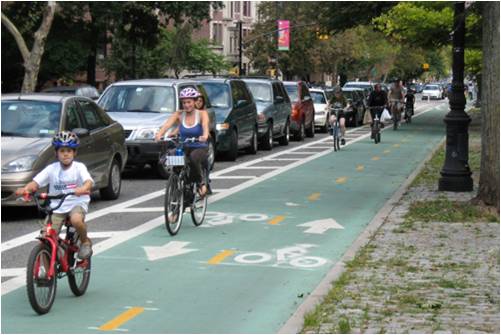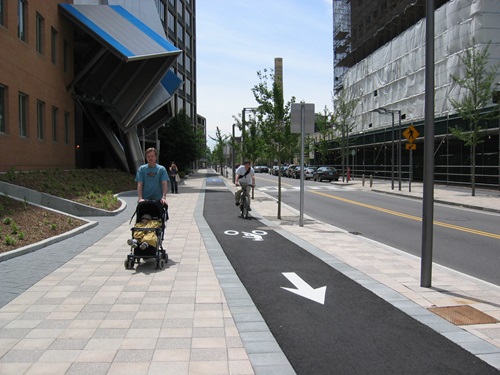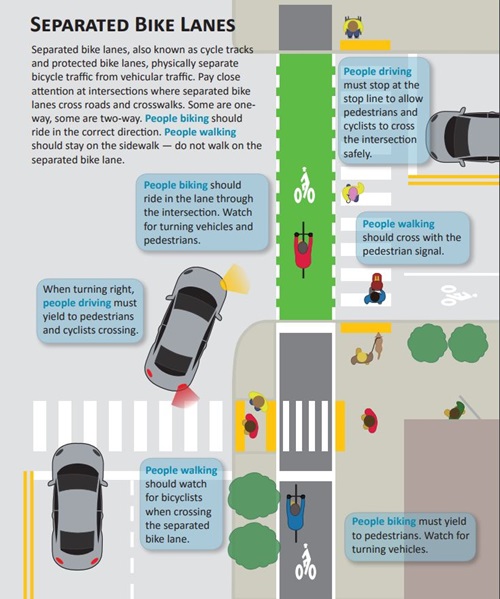Separated Bicycle Facilities
What is a Separated Bicycle Lane?
The term “separated bicycle facility” or “separated bike lane” generally refers to a bicycle facility with a physical separation from the motor vehicle travel area, often through barriers or grade separation. Sometimes also called protected bike lanes, raised bike lanes, or cycle tracks, they are typically located between the street or parking lane and the pedestrian sidewalk. Most designs reduce or eliminate the risk of dooring and research shows that separated bicycle lanes increase safety, supporting the City’s goal of creating more equitable transportation opportunities for people of all ages and abilities.
See current and planned separate bicycle lane locations.

Benefits of Separated Bike Lanes
- Increase comfort and safety for bicyclists through separation from motor vehicles to create a more path-like experience.
- More comfortable and accessible for people of all ages and abilities, including children and the elderly; attract new riders at all levels.
- Reduce crashes, overall injury risk, and fear of collisions with over-taking vehicles at mid-block.
- Remove bicyclists from the door zone, eliminating the risk of “dooring” and potentially being struck by a motor vehicle.
- Reduce or eliminate potential obstructions that occur commonly in bicycle lanes, such as motorists parking or driving in the lane.
- Providing a dedicated space for bicyclists improves clarity about expected behavior for all modes of travel.
- Enhance the pedestrian environment by creating a buffer between pedestrians and vehicle traffic adjacent to the sidewalk.
- Encourage traffic-averse cyclists to ride in a bicycle facility, rather than on the sidewalk
- Narrow the roadway width, either physically or visually, for traffic calming benefits and to help create a more human-scale environment.
- Intersection designs can reduce or separate conflicts with motorists.
- Provide a better air quality environment for users than riding in the roadway. The increased separation from motor vehicle traffic also provides better air quality for pedestrians.
- Provide economic benefits—they attract more bicyclists than standard bike lanes which results in more productive workers and more spending at local businesses.

Cambridge Locations
The City of Cambridge was one of the first cities in the United States to design and construct separated bicycle lanes. In 2004, a grade-separated bicycle lane was installed on Vassar Street from Main Street to Massachusetts Avenue, with full construction to Audrey Street completed in 2009. A second facility was later installed on Concord Avenue from Alewife Brook Parkway to Blanchard Road. The grade-separated bicycle facility built as part of the Western Avenue Reconstruction Project won a Best Bicycle Lane of the Year award from nation non-profit advocacy group PeopleForBikes.
There are many projects that have been completed or are close to completion, including the grade-separated bicycle facilities as part of the Binney Street/Galileo Galilei Way reconstruction. Raised separated lanes will also be created on Monsignor O’Brien Highway with that roadway reconstruction.
There are number of projects that are underway that are being designed as part of the implementation of the Cycling Safety Ordinance, including portions of Mass. Ave., Brattle Street, Garden Street and more.
Click here for a map of bicycle infrastructure around the city (note: this is not a route map).
Click here for a map of some ongoing projects (note: this is not an exhaustive list of all projects).
As a Driver, What am I Supposed to do?
- Do not block the bike lane: You may never drive or park in any bike lane, including separated bike lanes
- Watch for bikes when turning: Please make sure to look for and yield to bikes when entering or exiting a driveway or when turning at an intersection. You should always do this, at every driveway or intersection.
How Should Cyclists Use Protected Bike Lanes?
- Separated bike lanes afford the same access as regular bike lanes. As always, pay special attention at driveways and intersections for turning cars.
- Slower cyclists are encouraged to comfortably position themselves to the RIGHT side, so they may be passed by faster cyclists on the LEFT.

For More Information
For references on Separated Facility Design:
For some interesting reports of bike facilities from around the world, check out:
Staff Contact
For more information about bicycling in Cambridge, please contact cddat344@cambridgema.gov.